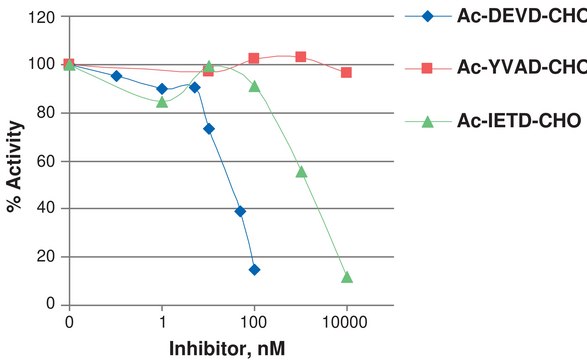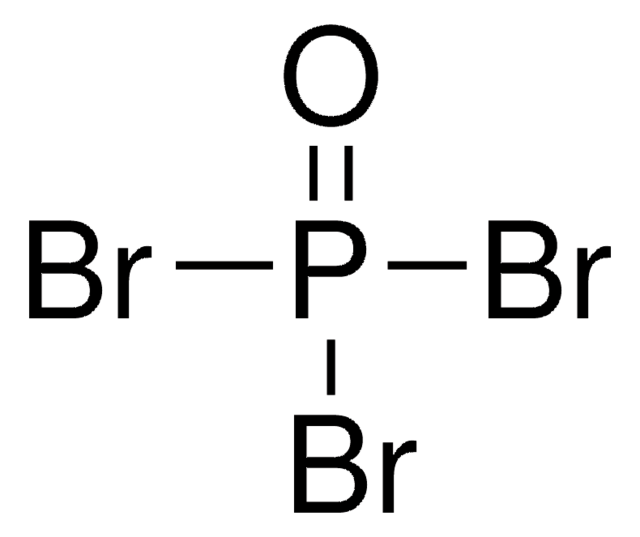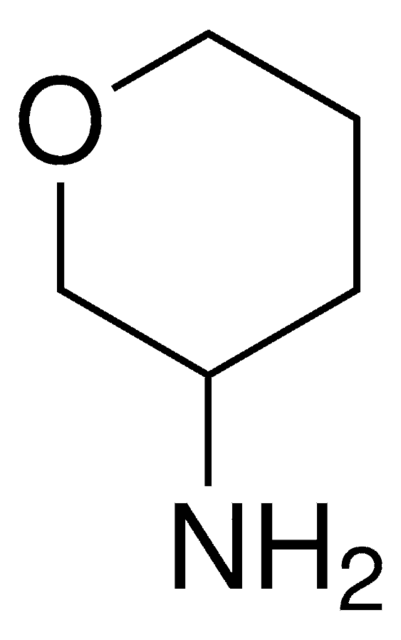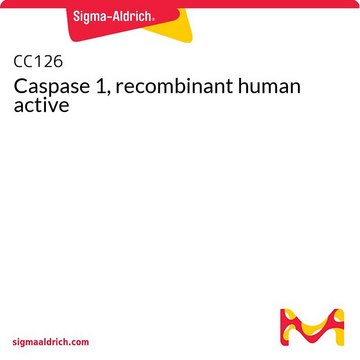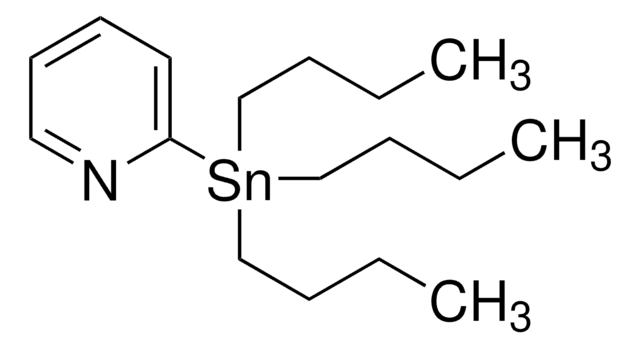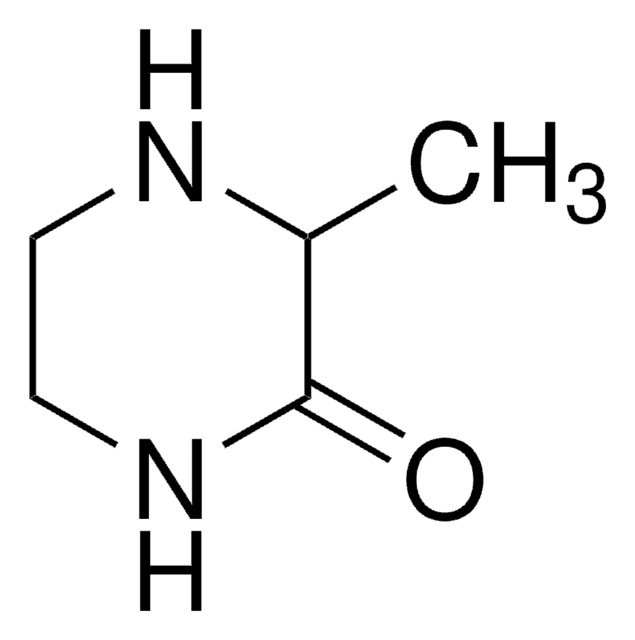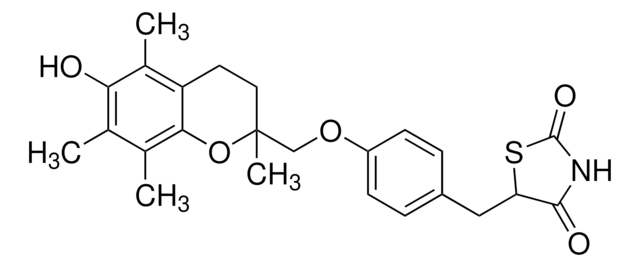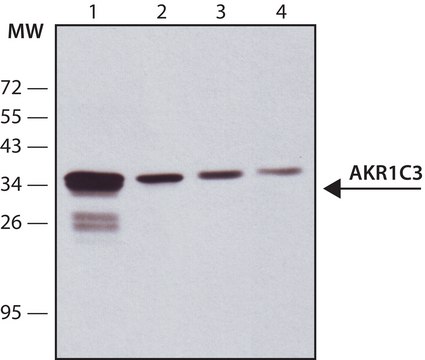Select a Size
All Photos(1)
Select a Size
Change View
About This Item
UNSPSC Code:
12352204
eCl@ss:
32160405
NACRES:
NA.41
Recommended Products
biological source
human
recombinant
expressed in E. coli
form
solid
manufacturer/tradename
Chemicon®
technique(s)
activity assay: suitable
NCBI accession no.
UniProt accession no.
shipped in
dry ice
Gene Information
human ... CASP3(836)
General description
Specificity: Caspase-3 (also known as CPP32, Yama and apopain) is a member of the interleukin-1beta converting enzyme (ICE) family of cysteine proteases. Caspase-3 exists in cells as an inactive 32 kDa proenzyme. During apoptosis procaspase-3 is processed at aspartate residues by self-proteolysis and/or cleavage by upstream caspases, such as caspase-6 (Mch2), caspase-8 (FLICE) granzyme B. The processed form of caspase-3 consists of large (17 kDa) and small (12 kDa) subunits which associate to form the active enzyme. The active caspase-3 has been shown involving in the proteolysis of several important molecules, such as poly (ADP-ribose) polymerase (PARP), the sterol regulatory element binding proteins (SREBPs), focal adhesion kinase (FAK), and others.
The partially purified* active recombinant human caspase-3 protein with full-length His-6 tag was expressed in E. coli. The expressed Caspase-3 spontaneously undergoes autoprocessing to yield the subunits characteristic of the native enzyme. The recombinant caspase-3 preferentially cleaves caspase-3 substrates (e.g., DEVD-AFC or DEVD-pNA). In combination with caspase-3 activity assays, the active recombinant caspase-3 is very useful in the biological screening of caspase inhibitors. The recombinant enzyme can also be used as a positive control in caspase assays or in determining the specificity of caspase substrates.
*10-25% caspase-3 protein by gel analysis, also contains E. Coli proteins. Approximately, 0.8-2 μg total protein / unit of activity. GenBank # U13737.
The partially purified* active recombinant human caspase-3 protein with full-length His-6 tag was expressed in E. coli. The expressed Caspase-3 spontaneously undergoes autoprocessing to yield the subunits characteristic of the native enzyme. The recombinant caspase-3 preferentially cleaves caspase-3 substrates (e.g., DEVD-AFC or DEVD-pNA). In combination with caspase-3 activity assays, the active recombinant caspase-3 is very useful in the biological screening of caspase inhibitors. The recombinant enzyme can also be used as a positive control in caspase assays or in determining the specificity of caspase substrates.
*10-25% caspase-3 protein by gel analysis, also contains E. Coli proteins. Approximately, 0.8-2 μg total protein / unit of activity. GenBank # U13737.
Application
Western blot: 1-5 μL of stock per lane. Protein is full length caspase 3 with His-Tag. It is autoactivated thus active caspase subunits will be seen
and 17kDa + 12kDa (large and small subunits) can be seen depending upon the antibody. Small subunit is extremely difficult to detect in most westerns. The size of inactive enzime is ~32 kDa.
Activation: Not needed. When expressed in E. coli, caspase-3 spontaneously undergoes autoprocessing to yield the subunits characteristic of the active enzyme.
and 17kDa + 12kDa (large and small subunits) can be seen depending upon the antibody. Small subunit is extremely difficult to detect in most westerns. The size of inactive enzime is ~32 kDa.
Activation: Not needed. When expressed in E. coli, caspase-3 spontaneously undergoes autoprocessing to yield the subunits characteristic of the active enzyme.
Unit Definition
Specific Activity: One unit of the recombinant caspase-3 is the enzyme activity that cleaves 1 nmol of the caspase substrate DEVD-pNA (pNA: pnitroanaline) per hour at 37°C at saturated substrate concentrations.
Physical form
Lyophilized. Reconstitute to 1 unit/μL with PBS containing 15% glycerol.
Partially purified recombinant caspase 3 with a full length HIS-6-tag. Approximately 10-20% caspase 3 protein. The remainder is E.Coli proteins. Approximately 0.8-2 mg total protein/U of activity; E.Coli proteins have no reactivity.
Partially purified recombinant caspase 3 with a full length HIS-6-tag. Approximately 10-20% caspase 3 protein. The remainder is E.Coli proteins. Approximately 0.8-2 mg total protein/U of activity; E.Coli proteins have no reactivity.
Storage and Stability
Maintain unopened and rehydrated product at -70°C in undiluted, freeze-thaw protected, tightly sealed aliquots. Avoid repeated freeze/thaw cycles. Product stable for 6 months from date of purchased if handled appropriately.
Analysis Note
Partially purified recombinant caspase 3 with a full length HIS-6-tag. Approximately 10-20% caspase 3 protein. The remainder is E.Coli proteins. Approximately 0.8-2 mg total protein/U of activity; E.Coli proteins have no reactivity.
Legal Information
CHEMICON is a registered trademark of Merck KGaA, Darmstadt, Germany
Disclaimer
Unless otherwise stated in our catalog or other company documentation accompanying the product(s), our products are intended for research use only and are not to be used for any other purpose, which includes but is not limited to, unauthorized commercial uses, in vitro diagnostic uses, ex vivo or in vivo therapeutic uses or any type of consumption or application to humans or animals.
Storage Class Code
11 - Combustible Solids
WGK
WGK 1
Flash Point(F)
Not applicable
Flash Point(C)
Not applicable
Certificates of Analysis (COA)
Search for Certificates of Analysis (COA) by entering the products Lot/Batch Number. Lot and Batch Numbers can be found on a product’s label following the words ‘Lot’ or ‘Batch’.
Already Own This Product?
Find documentation for the products that you have recently purchased in the Document Library.
Enterocyte proliferation and apoptosis in the caudal small intestine is influenced by the composition of colonizing commensal bacteria in the neonatal gnotobiotic pig.
B P Willing,A G Van Kessel
Journal of Animal Science null
Frances J Northington et al.
Journal of cerebral blood flow and metabolism : official journal of the International Society of Cerebral Blood Flow and Metabolism, 31(1), 178-189 (2010-06-24)
Necrostatin-1 inhibits receptor-interacting protein (RIP)-1 kinase and programmed necrosis and is neuroprotective in adult rodent models. Owing to the prominence of necrosis and continuum cell death in neonatal hypoxia-ischemia (HI), we tested whether necrostatin was neuroprotective in the developing brain.
Jiro Fujita et al.
Microbiology and immunology, 47(6), 447-451 (2003-08-09)
In a previous study, we demonstrated anti-vimentin antibodies in sera of patients with interstitial pneumonia. We hypothesized that antibodies in sera might detect vimentin fragments formed during the process of apoptosis. To prove this, recombinant human vimentin was digested by
Qianyue Chen et al.
European journal of immunology, 51(5), 1234-1245 (2021-01-18)
Pyroptosis is a type of acute cell death that mainly occurs in immune cells. It is characterized with robust release of inflammatory cytokines and has emerged to play a critical role in the pathogenesis of sepsis-associated immune disorders. In this
Ming Cheng Liu et al.
Journal of neurochemistry, 98(3), 700-712 (2006-08-09)
Axonal injury is one of the key features of traumatic brain injury (TBI), yet little is known about the integrity of the myelin sheath. We report that the 21.5 and 18.5-kDa myelin basic protein (MBP) isoforms degrade into N-terminal fragments
Our team of scientists has experience in all areas of research including Life Science, Material Science, Chemical Synthesis, Chromatography, Analytical and many others.
Contact Technical Service